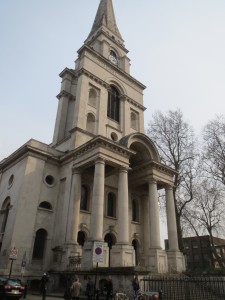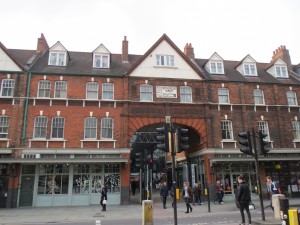SIGHT (Commercial Street): You are now on Commercial Street. Just across the street you’ll see The Culpepper, which is today a fairly trendy gastro-pub. Until recently it was known as The Princess Alice, a rather run down and traditional pub, which looked nothing like what it does not. You might pop in here a quick pint, but we recommend that continue on for just another five minutes before stopping.
Just down the street (south) on the same side as The Culpepper, is the Toynbee Hall, a Grade II listed building erected in 1884 as the first university settlement house of the so-called settlement movement. The idea was to get the rich and poor to live closer together to bridge the differences in society, and so Toynbee Hall became home to a number of students from Oxford and Cambridge who lived there to undertake social work in the deprived areas surrounding the hall. Built in vicarage-gothic style, Toynbee Hall is still a major center of charity in east London.
Turn back and go north on Commercial Street. After a few hundred meters you will see a rather (if not very) ugly and out-of-place multi-storey cark park on your right, followed by a narrow (and closed) pass through with storage facilities on the other side. This was once the site of Dorset Street, known for years as “the worst street in London”. An entire book has been written about Dorset Street under that very title. Basically, the street was for centuries home to the lowest people of London. Prostitutes and criminals living in common lodging houses in an environment where even the police feared to go. Two of Jack the Ripper’s victims stayed here, and one of them, an unfortunate young Irish girl named Mary Kelly, was brutally slaughtered in her small room in Miller’s Court, a small court of Dorset Street the exact location of which is now covered by the storage rooms. The north side of Dorset Street (which had by then changed it’s name to Duval Street) was demolished and redeveloped in the 1920s and the south side in the 1960s.
SIGHT (Christ Church): Opposite Duval Street/Dorset Street on the right side of Commercial Street (facing north) is Christ Church. Contrary to popular belief, this white church has not lend its name to the general area of Whitechapel, but more about this later. Christ Church was built 1714 to 1729 to a design by Nicholas Hawksmoor, who had formerly been the principal assistant to Sir Christopher Wren during the building of St. Paul’s Cathedral. Shortly after it’s opening, the church had installed an organ by Richard Bridge, which was for more than a century the largest in all of England with more than 2000 pipes. Changes was later made to the organ, but by 1960 the organ as well as the church itself had become derelict and in danger of demolition. By 1987 the church had become partially restored and the restoration was completed in 2004. In 2014 restoration of the organ was done, and the Bridge organ was heard in the church for the first time in 50 years.
PUB (Ten Bells / Pint): Just next to the church is the Ten Bells pub, which has been in this exact location since the 1850s. From 1976 to 1988 it was known as “The Jack the Ripper”, but it has now reverted to its more traditional name, which has always been associated with the number of bells in the adjacent church. It is decorated with beautiful Victorian tiling and has been a Grade II listed building since 1973. The downstairs toilets are an experience all by themselves. It is not a very large place though, so expect it to be fairly crowded. There is actually a lesser known upstairs restaurant associated with the pub. It is supposed to be rather good, but unless you are very hungry by now, just have a pint or two and wait half an hour before having some of the very excellent street food which is available in the neighbourhood.
SIGHT (Old Spitalfields Market): Opposite the Ten Bells is the Old Spitalfields Market. There has been a market on this place for more than 300 years, but it is today a rather modern place, featuring all sorts of stalls, cutting-edge fashion, food bars etc. Apart from the 1887 frontage of the market towards Commercial Street, little remains of the old market buildings. You can have a bit of food in here, or you can wait just a few minutes more until the next stop on the tour. Occassionally, Old Spitalfields hosts the London Brewers Market, a free event where visitors can have a chat with the teams behind some local London breweries and taste their products. You can read more about the London Brewers Market and upcoming dates here.


